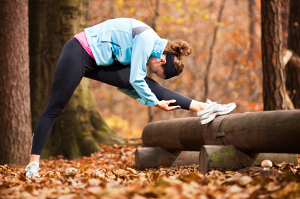Basics of stretching
Warm up before stretching
A warm-up is the most important and indispensable part of every workout. Thanks to the warm-up, the likelihood of injury during exercises is significantly reduced, and performance during your workout becomes better. Hot muscles are more efficient, and major training exercises are easier to perform because the body is prepared for them.
Regardless of the type and level of exercise performed - you need to warm up before exercising!
Visit our website simplewarmup.com, where we've presented a complete list of warm-up exercises developed by us that will help you prepare for your workout.
Of course, if you stretch after a workout, you do not need any warm up for the second time. Warming up just before the workout is sufficient.
 Stretch all muscle groups
Stretch all muscle groups
It is best to stretch all the basic muscle groups.
- Neck and back
- Chest
- Hips
- Thighs
- Calves
The effects very much depend on a predisposition, age, etc.
Our stretching training has been created so that everyone can stretch, improve flexibility and suppleness. The effects of these training sessions, however, will vary widely depending on the person. In general:
- The older you are, the weaker the effects.
- If you are a man, the effects will be weaker.
- If you never stretched, the effects will be weaker.
- The more muscular you are, the weaker the effects.
- If you are predisposed, the effects will be much better than in case of people who are not.
Everybody has his own limits. For example, many people over the age of 20 who have never stretched will never do a split. Not everybody may touch the head to the knees, etc.
Everybody can increase his flexibility and range of motion, as well as improve mood and posture. Stretching is worth the time and we strongly encourage doing it.
Please, be cautious
The stretching gives the best results when performed on a regular basis and not when it is done intensively. Reaching the threshold of pain, strong dynamic loading of tendons, or static bending by the partner may be dangerous. If you are not training under the supervision of a specialist who monitors your situation, we definitely do not recommend these techniques.
Types of stretching
There are several types of stretching techniques. We offer the most popular, yet safest - static passive technique, involving the painless stretching and holding in that position for several seconds.
The biggest advantages of the static method are its effectiveness combined with the practitioner’s safety. This technique can be used by anyone without fear of side effects and injuries.
Other techniques - active PNF stretching, may in various cases give faster, clearer results, however, to use these techniques you need more knowledge or training under the supervision of a specialist. Otherwise, you may end up injured or even achieve an effect opposite to intended one, namely, to trigger defensive reactions of the body, which will protect itself against the injury and will shorten and stiffen the tendons.
Our training includes PNF (active stretching) elements, but only where it is really safe and we clearly describe how to practice in order to avoid injuries.
